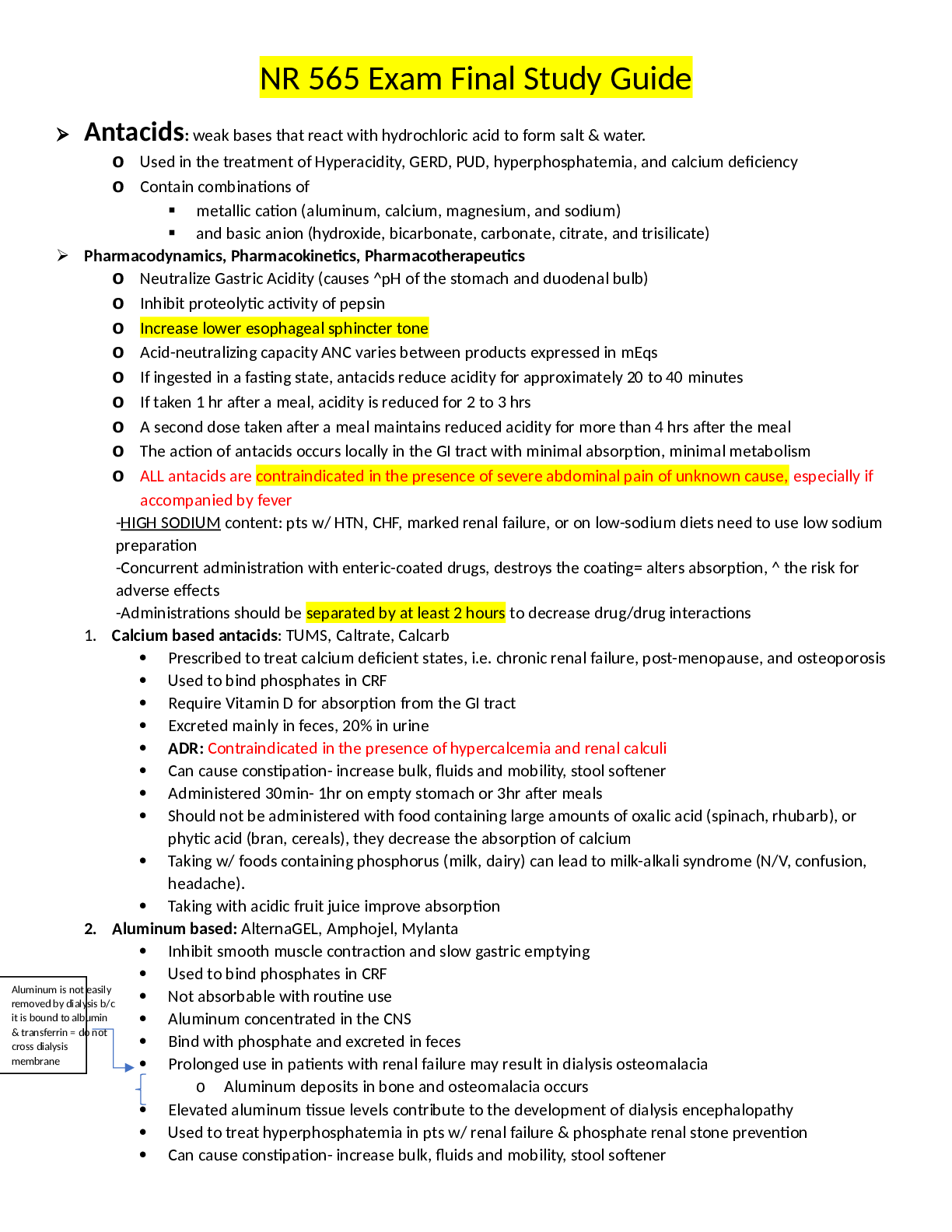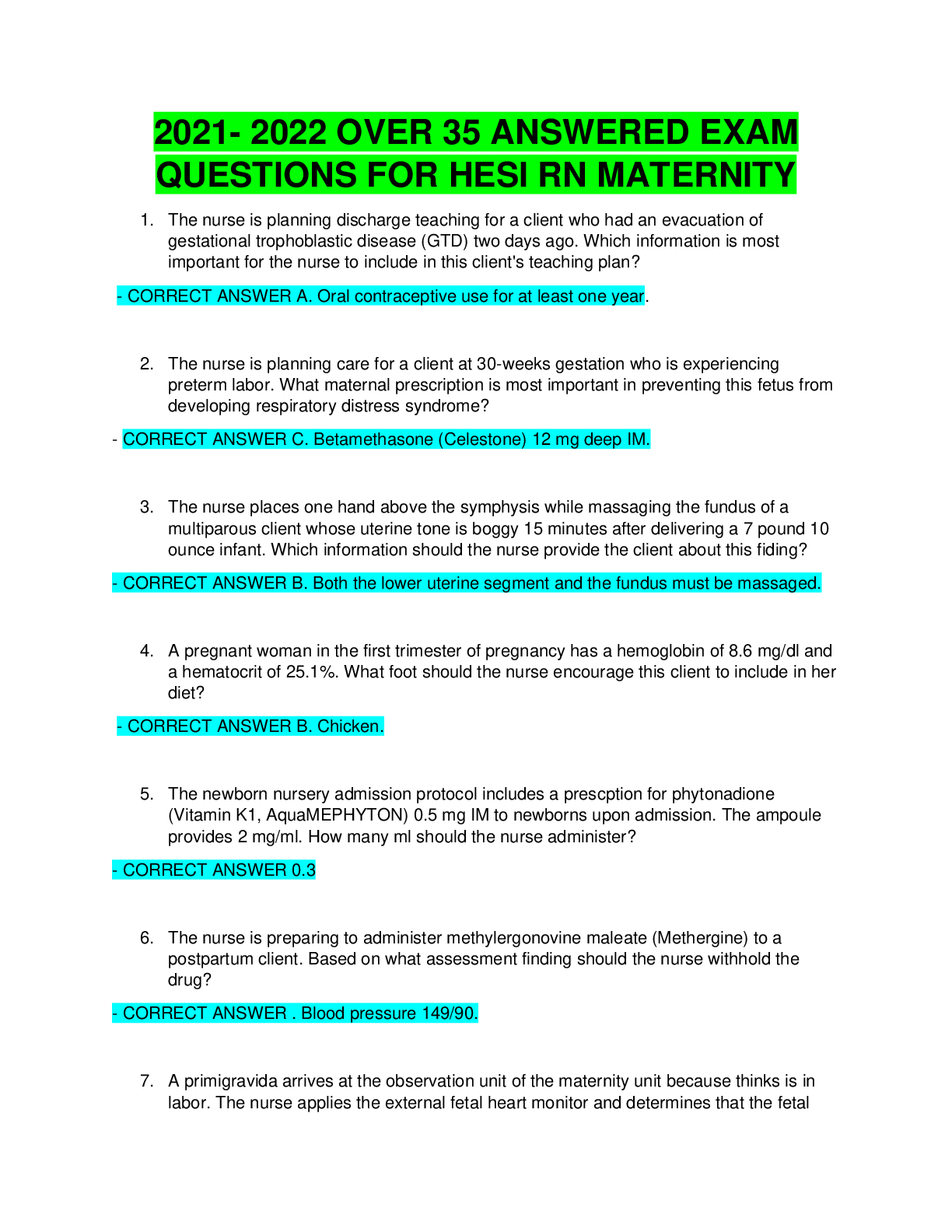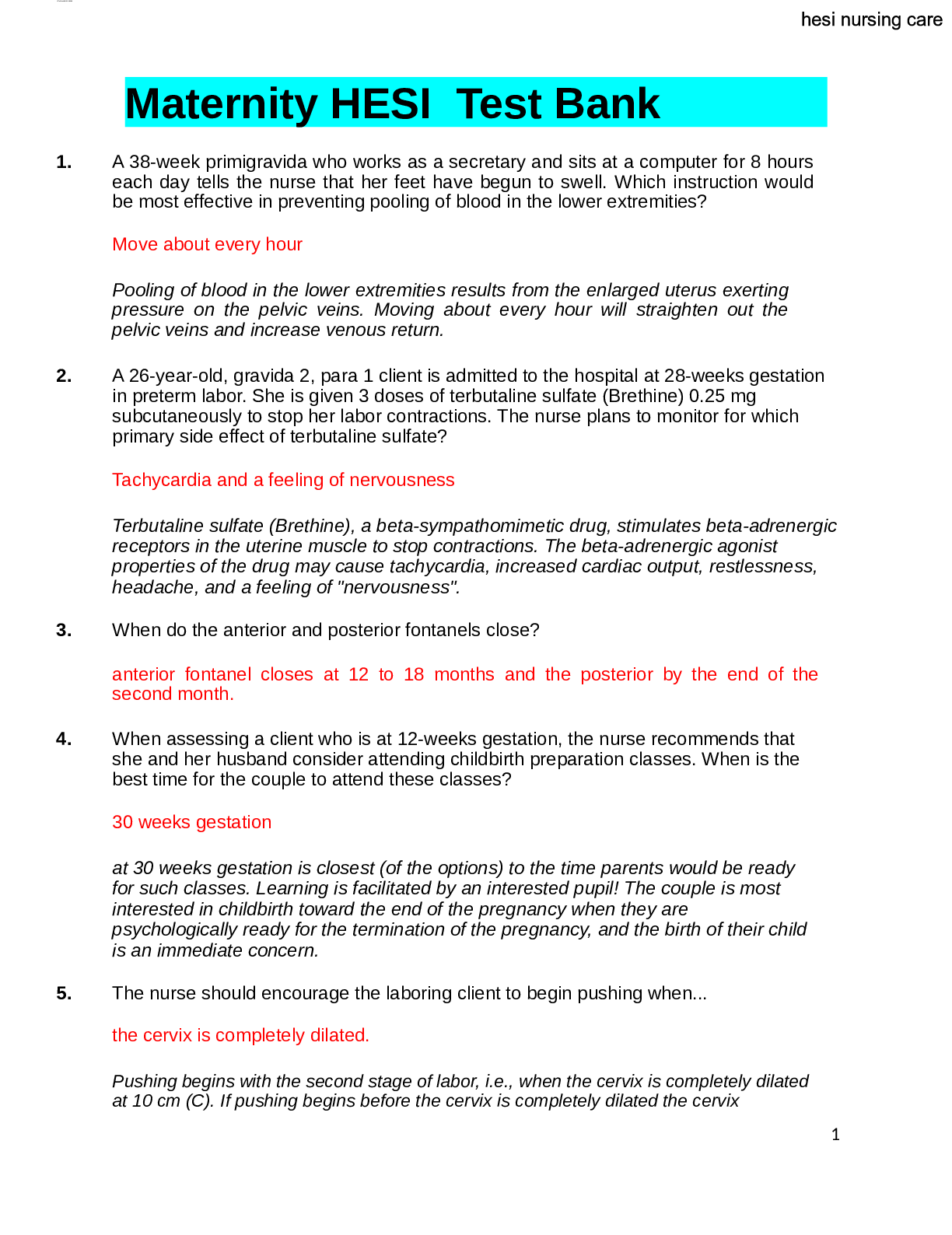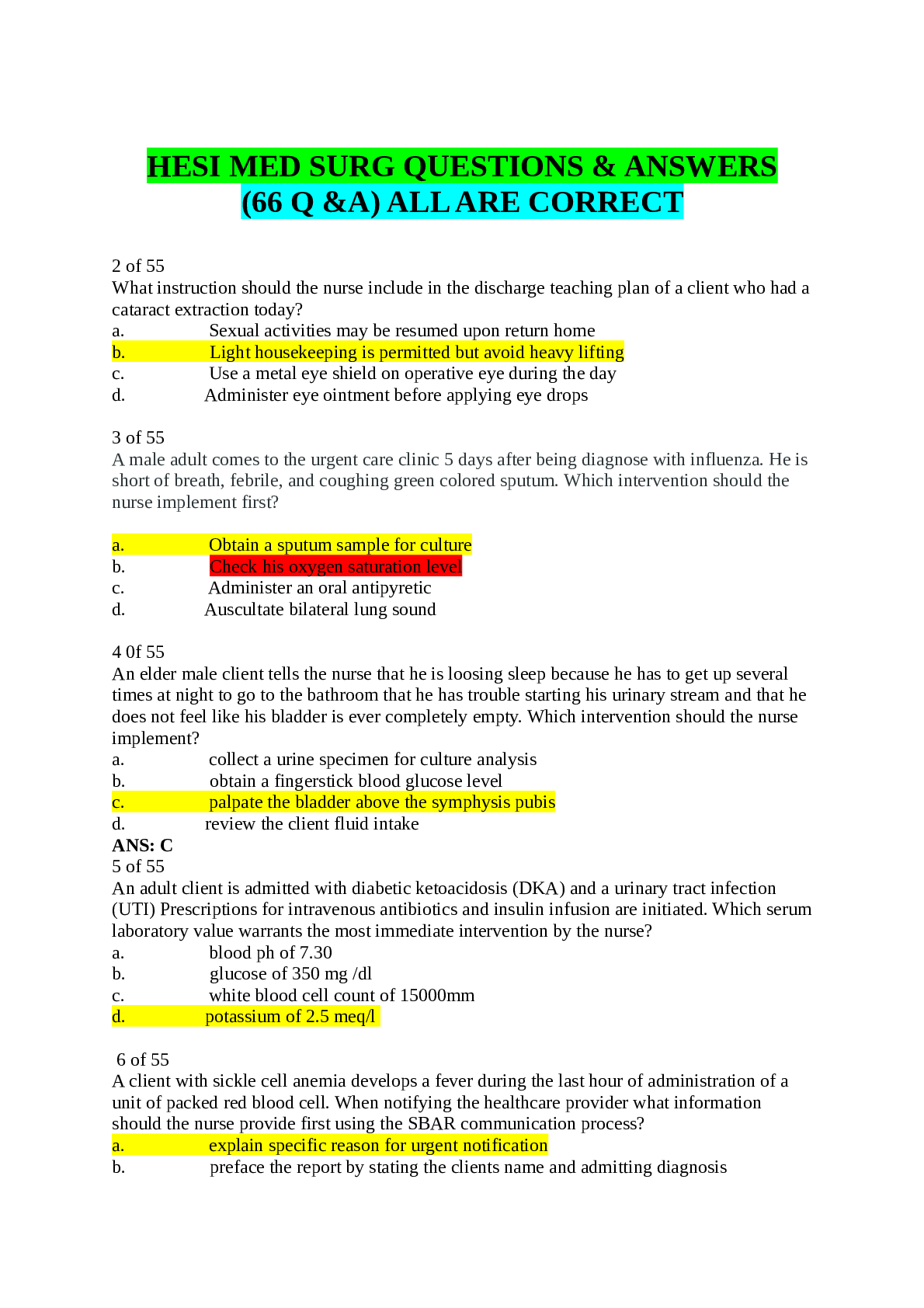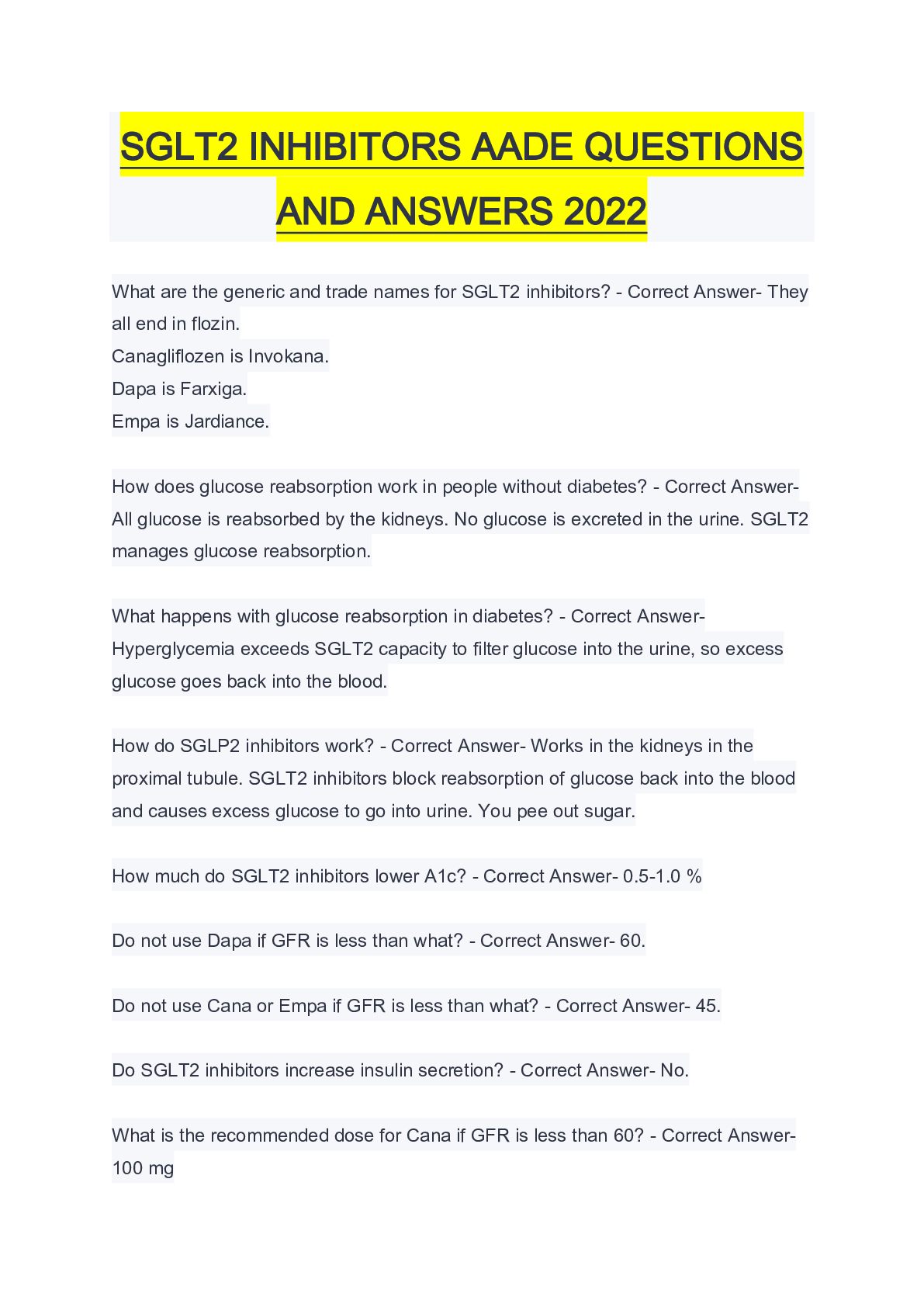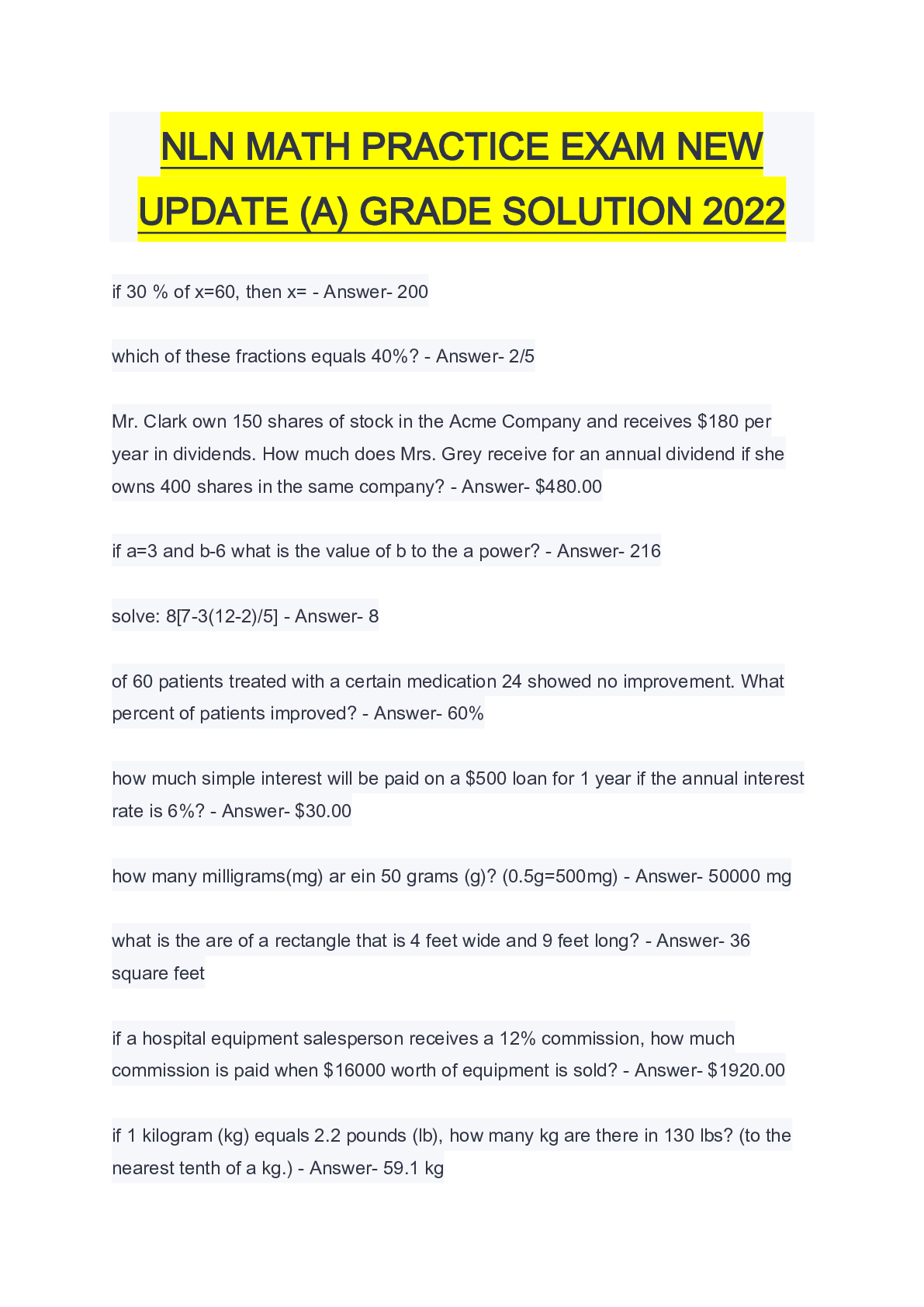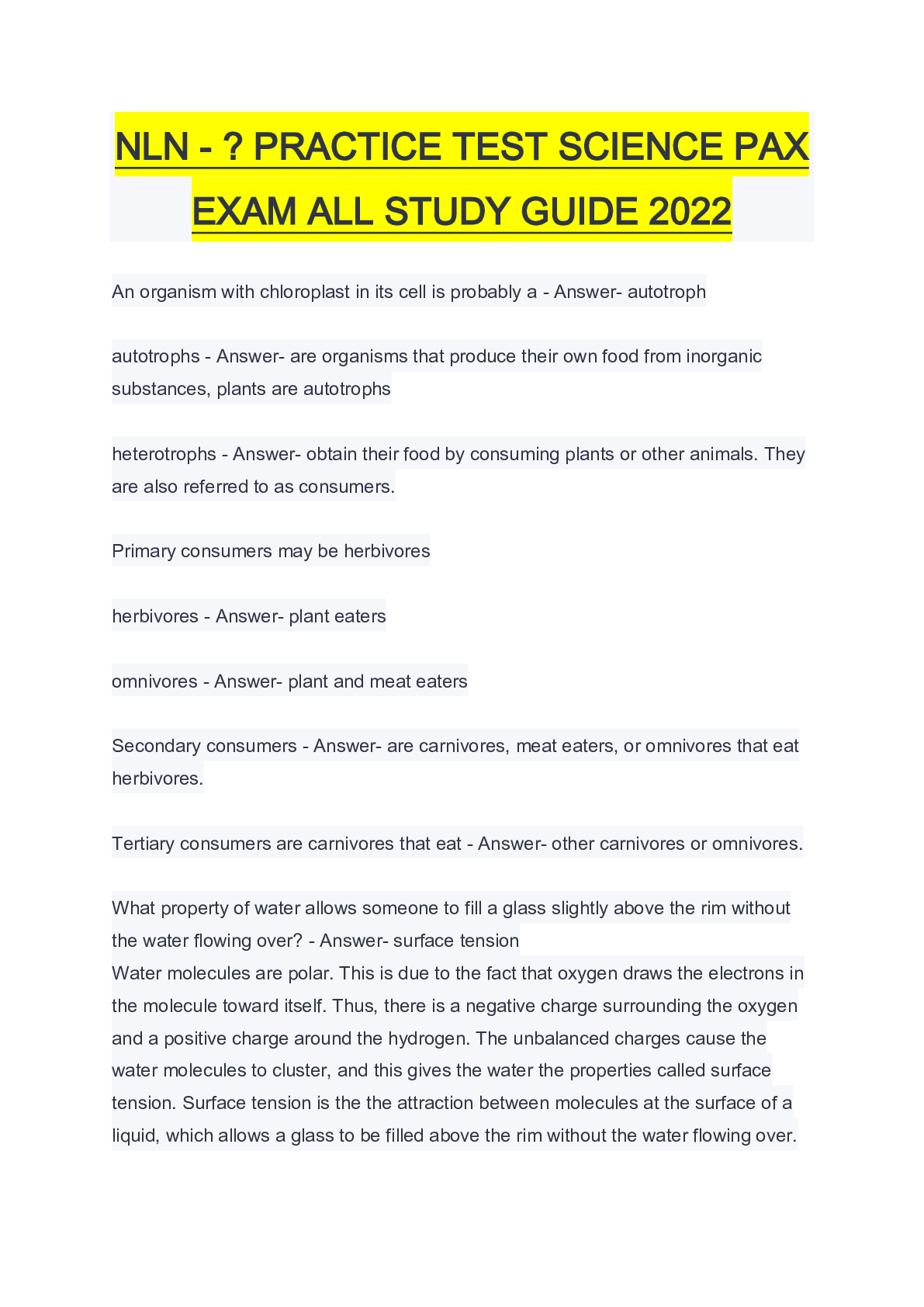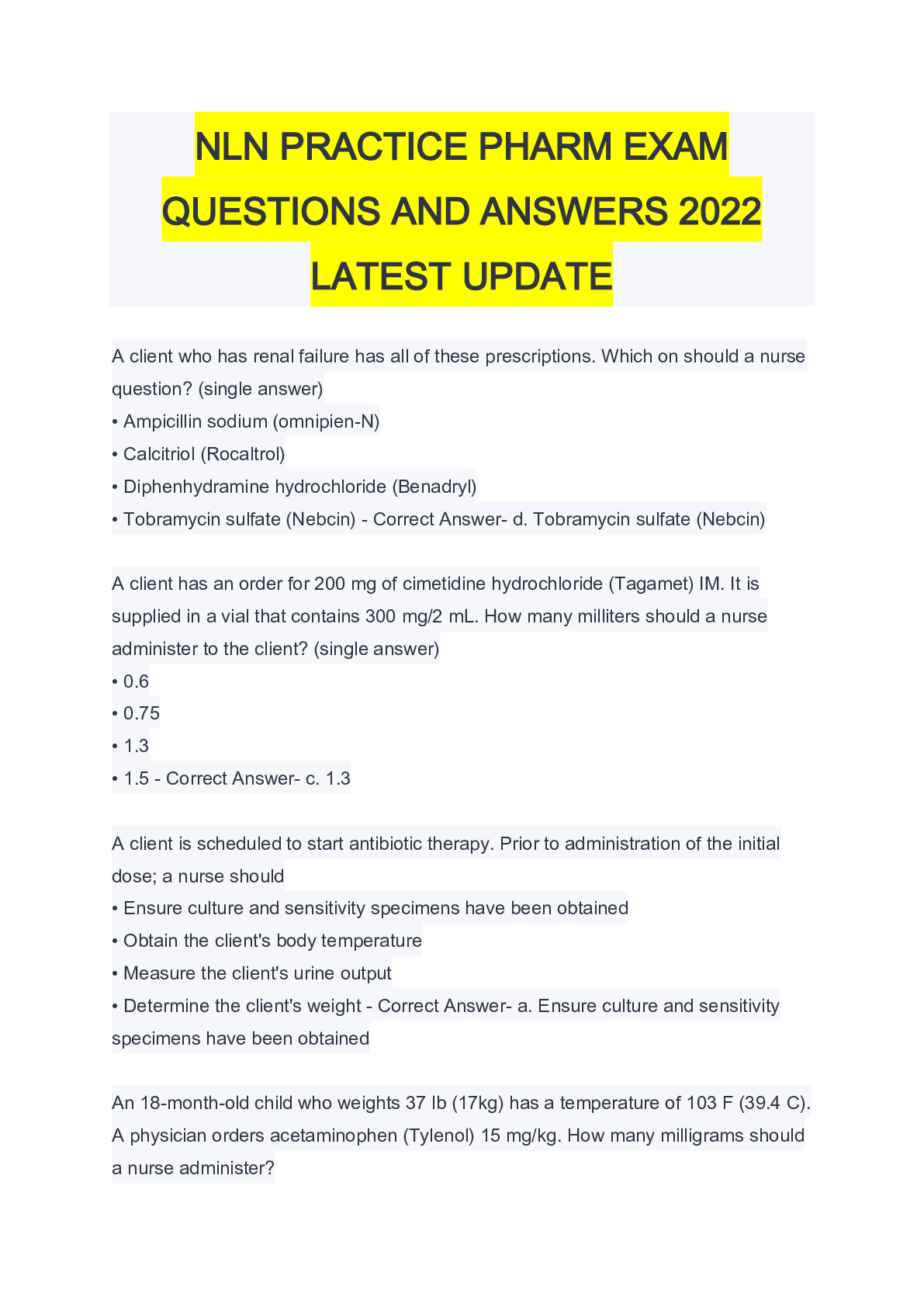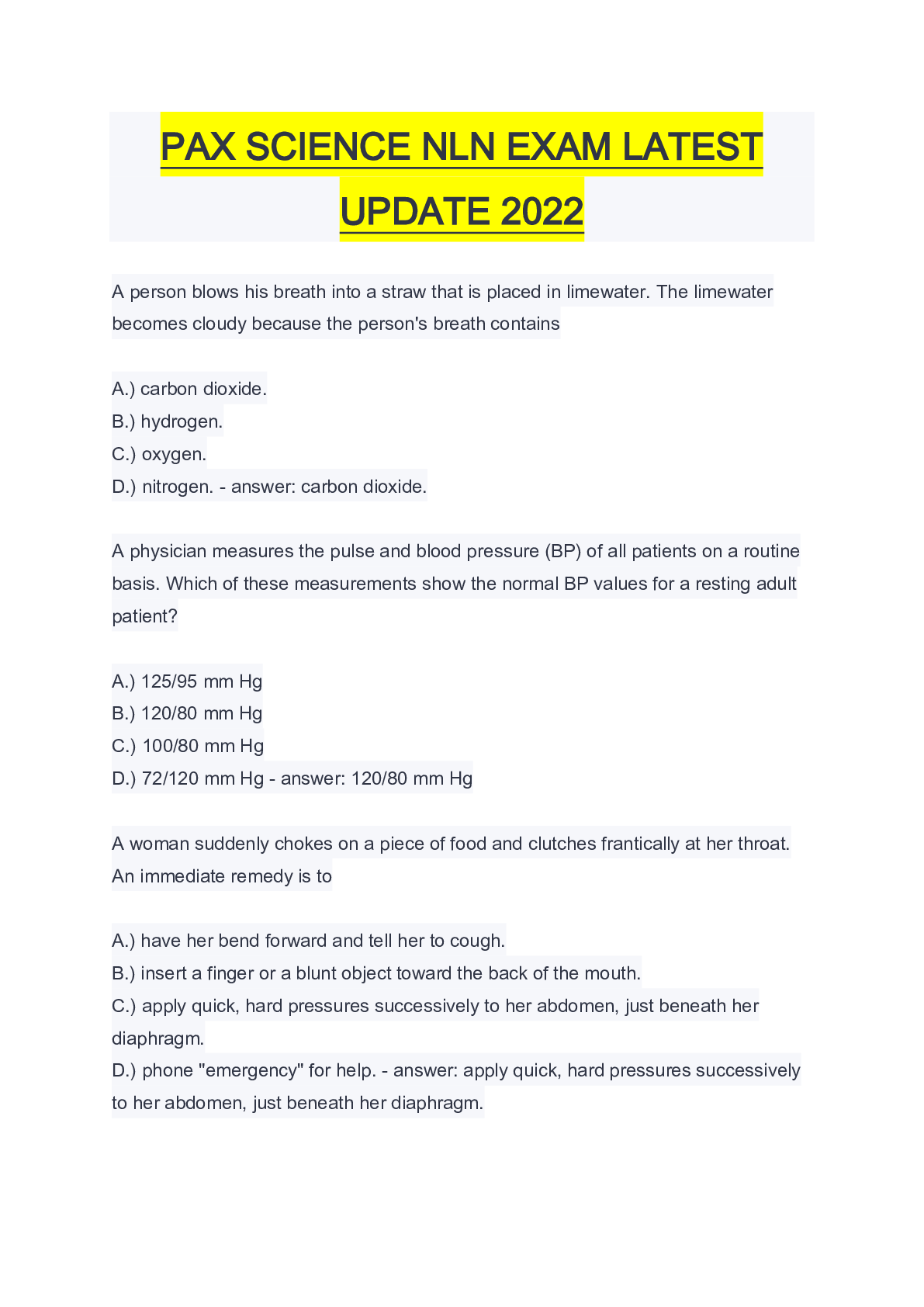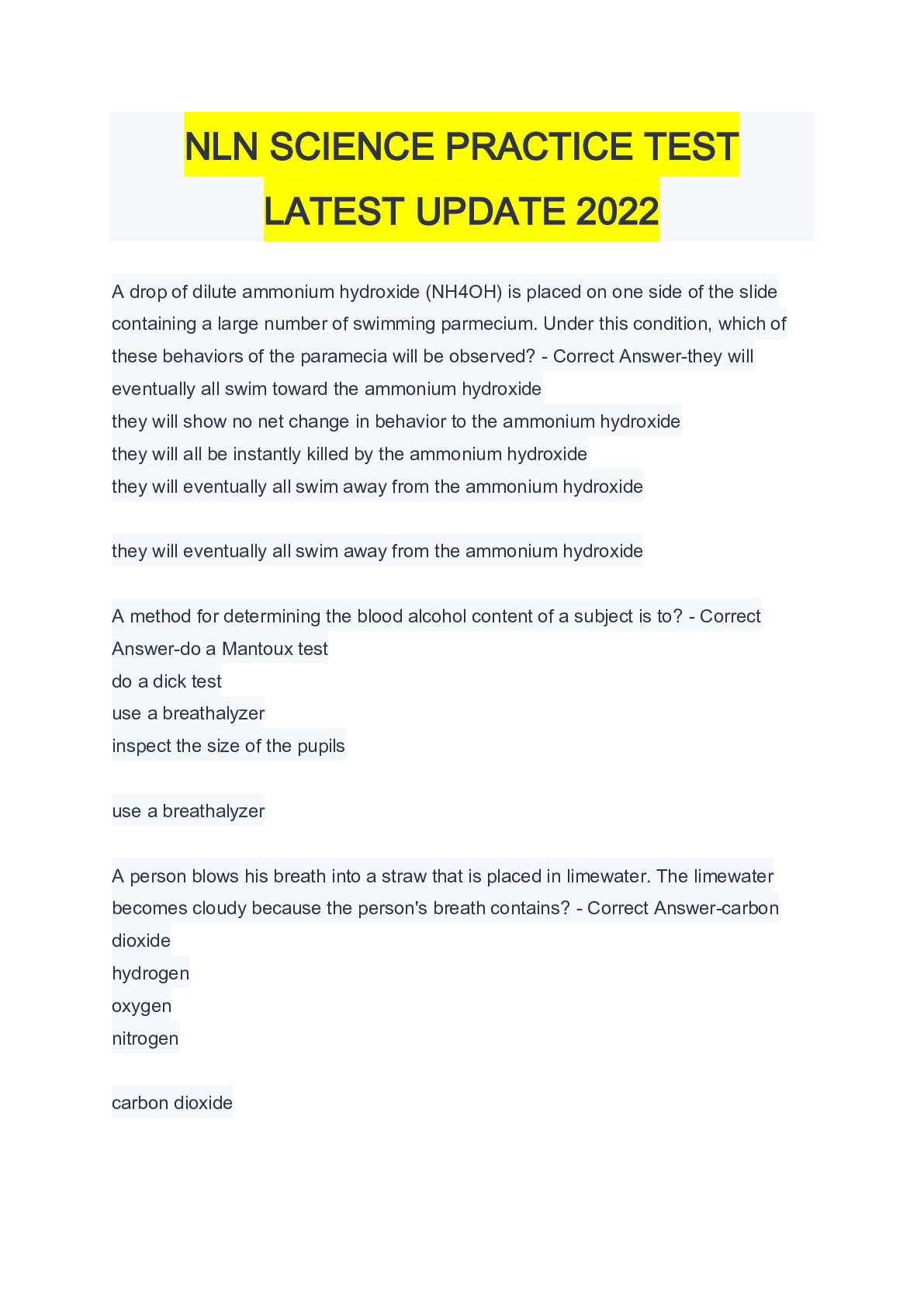Chapter 17: Nose, Mouth, Throat Exam 2022-2023
Document Content and Description Below
Chapter 17: Nose, Mouth, Throat Exam 2022-2023 Nose - Answer- -Is the first segment of the respiratory system. - It warms, moistens, and filters the inhaled air, and it is the sensory organ for s... mell. Nasal Cavity - Answer- -Is much larger than the external nose would indicate -It extends back over the roof of the mouth Septum - Answer- Divides the naval cavity medially into two slit like passages. Turbinates - Answer- The lateral walls of each nasal cavity contain 3 parallel bony projections- the superior, middle, and inferior turbinates. Note to self: -They increase surface area so more blood vessels and mucous membranes are available to warm, humidify, and filter the inhaled air. (Gaps in between tissue in sinus) -Cannot see superior turbinate when assessing Olfactory Receptors - Answer- -(hair cells) lie at the roof of the nasal cavity and in the upper one third of the septum. -These receptors for smell merge into the olfactory nerve, cranial nerve I, which transmits to the temporal lobe of the brain. Bridge and Tip - Answer- On its leading edge at the superior part of the bridge, and the free corner is the tip. Nares - Answer- The oval openings at the base of the triangle are the nares (nostrils). Columella - Answer- -Divides the two nares and is continuous inside with the nasal septum. Note to self: -Part in between nostrils Ala - Answer- the lateral outside wing on the nose on either side. Note to self: outside ring of nose on the ends of the nostrils Paranasal Sinuses - Answer- -air-filled pockets within the cranium. -They communicate with the nasal cavity and are lined with the same kind of ciliated mucous. Frontal Sinus - Answer- In the frontal bone above and medial to the orbits Maxilla Sinus - Answer- sinuses in the maxilla (cheekbone) alongside the walls of the naval cavity. Ethmoid Sinus - Answer- between the orbits Note to self: -Pockets in the upper side part of the nose Sphenoid Sinus - Answer- Deep within the skull in the sphenoid bone. Note to self: -Near ear Mouth - Answer- -First segment of the digestive system and an airway for the respiratory system. Oral Cavity - Answer- -A short passage bordered by the lips, palate, cheeks, and tongue. What does it contain -Contains the teeth, gums, tongue, and salivary glands. Note to self: -Whole mouth -Oral cavity and throat have a rich lymphatic network. Palate - Answer- arching roof of the mouth; divided into two parts. First part: Anterior Hard Palate - Answer- -Is made up of bone whitish color. Second Part: Posterior to Anterior Hard Palate is the soft palate - Answer- -An arch of muscle that is pinker in color and mobile. Uvula - Answer- -is the free projection hanging down the middle of the soft palate. Cheeks - Answer- -Side walls of the oral cavity Tongue - Answer- is a mass of striated muscle arranged in a crosswise pattern so it can change shape and position. Note to self: -The ability of the tongue to change shape and position enhances its function in mastication (moist), swallowing, teeth cleansing, and speech formation. Frenulum - Answer- is a midline fold of tissue that connects the tongue to the floor of the mouth What are the three pairs of salivary glands in the mouth? - Answer- Largest: Parotid Gland -Lies within the cheeks in front of the ear, extending from the zygomatic arch down to the angle of the jaw. Submandibular: -Gland is the size of a walnut -It lies beneath the mandible at the angle of the jaw. (bottom part of jaw by check towards lips) Sublingual: -lies within the floor of the mouth under the tongue. It has many small openings along the sublingual fold under the tongue. What do these glands do? -Secrete saliva, clear fluid that moistens and lubricate the food bolus, start digestion, and cleans and protects the mucosa. Throat - Answer- aka pharynx is the area behind the mouth of the nose. Note to self: -Oral cavity and throat have a rich lymphatic network. Oropharynx - Answer- is separated from the mouth by a fold of tissue on each side, the anterior tonsillar pillar. Tonsils - Answer- -Behind the folds are where the tonsils are. -Each a mass of lymphoid tissue -The tonsils are the same color as the surrounding mucous membrane although they look more granular and their surface shows deep crypts. Nasopharynx - Answer- -is continuous with the oropharynx although it is above the oropharynx and behind the nasal cavity. What happens to the skin of the aging adult? - Answer- -A gradual loss of subcutaneous fat starts during the later adult years. Nose: -Appears more prominent Oral Cavity -The soft tissue atrophy (starts to disintegrate) -Epithelium thins (especially in the cheeks and tongue) This results in a loss of taste buds with an 80% reduction in taste functioning. -Further impairments to taste include a decrease in salivary secretion that is needed to dissolve flavoring agents. -Risk for malignant oral lesions also increases. Dental: -Many dental changes occur with aging. -The tooth surfaced is abraded (erode) -Gums begin to recede -Teeth begin to erode at the gum line. -Some tooth loss may occur from bone resorption (osteoporosis), which decreases its inner tooth structure and its outer support. -When tooth lose occurs the remaining teeth drift; causing malocclusion. -The stress of chewing with malocclusion teeth causes: 1)Further tooth lose 2)Muscle imbalance from a mandible and maxilla now out of alignment; produces muscle spasms, tenderness, and chronic headaches 3)Stress on the temporomandibular joint, leading to osteoarthritis, pain, and inability to fully open mouth. Subjective Data: Nose - Answer- 1)Discharge -Any nasal discharge or runny nose? -Is the discharge watery, purulent, mucoid, bloody? Rationale: Rhinorrhea (discharge from nose) -> Occurs with colds, allergies, sinus infection and trauma. 2)Frequent Colds -Any unusual frequent or severe colds (upper respiratory infections)? -How often do these occur? Most people have occasional colds; thus asking for more precise question yields more meaningful data. 3)Sinus pain -Any sinus pain or sinusitis? -How is it treated? -Do you have chronic postnasal drip? Up to 90% of patients with viral URI also have viral sinusitis, which resolves without antibiotics 4)Trauma -Ever had any or blow to the nose? -Can you breath through your nose? -Are both sides obstructed or one? Trauma may cause a deviated septum, which may cause nares to be obstructed. 5)Epistaxis (NOSEBLEEDS) -Any nose bleeds? -How often? -How much bleeding-teaspoonful or does it pour out? -Color of blood? red, brown, or clots Epistaxis occurs with trauma, vigorous nose blowing, foreign body. 6)Allergies -Any allergies or hay fever? -To what are you allergic to? -How was this determined? -Which type of environment makes it worse? Can you avoid exposure? -Use inhalers, nasal sprays, nose drops? How often? Which type? Misuse of nasal medications irritates the mucosa, causing rebound swelling, a common problem. 7)Altered Smell -Experience any change in sense of smell? Sense of smell diminishes with cigarette, smoking, chronic allergies, aging. Subjective Data: Mouth and Throat - Answer- 1)Sore Lesions -Noticed any sores or lesions in the mouth, tongue, or gums? -How long have you had them? Ever had this lesion before? -Is it single or multiple? -Does it seem to be associated with stress, season change, food? -Have you treated this sore? Apply any local medication? 2)Sore Throat -How frequently do you get them? -Have a sore throat now? When did it start? -Is it associated with cough, fever, fatigue, decreased appetite, headache, postnasal drip, or hoarseness? -Is it worse when arising? What is the humidity level in the room when you sleep? Any dust or smoke inhaled at work? -Usually get a throat culture for sore throats? Were any documented as streptococcal? -Have you treated this sore throat: medication, gargling? -How effective are these? Have your tonsils or adenoids(glands in nose) been removed? Most sore throats are viral and resolve in 3-5 days without antibiotics. However, group A streptococcal (GAS) pharyngitis is more likely with fever over 100.4F, absence of cough, tonsillar exudates, and cervical adenopathy (enlarged lymph nodes). Confirm with antigen test and backup throat culture. Untreated GAS can cause peritonsillar abscess, rheumatic fever, and glomerulonephritis 3)Bleeding Gums -Any bleeding gums? -How long have you had them? 4)Hoarseness -Any hoarseness, voice changing? For how long? -Feel like having to clear your throat? Or like a "lump in your throat" -Use your voice a lot at work, recreation? -Does this hoarseness seem associated with cold, sore throat? 5)Dysphagia -Any difficulty swallowing? Dysphagia occurs with pharyngitis, gastroesophageal reflux disease. 6) Altered Taste -Any change in sense of taste? 7)Smoking, alcohol consumption -When was your last alcoholic drink? -How much alcohol do you drink at a time? - How much alcohol do you usually drink? 8)Patient centered care -Last dental examination? -Do you have dental examination? -Do you have any dental appliances: braces, bridge, head gear? -Wear dentures -Any sort of irritation on the palate or gums? Lesions may arise from ill fitting dentures, or the presence of dentures may mask the eruptions of new lesions. CONTINUES..... [Show More]
Last updated: 1 year ago
Preview 1 out of 10 pages
Instant download

Buy this document to get the full access instantly
Instant Download Access after purchase
Add to cartInstant download
Reviews( 0 )
Document information
Connected school, study & course
About the document
Uploaded On
Sep 04, 2022
Number of pages
10
Written in
Additional information
This document has been written for:
Uploaded
Sep 04, 2022
Downloads
0
Views
25


